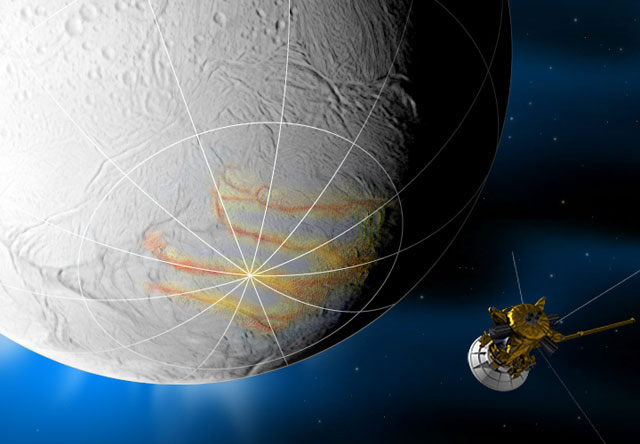Cassini Spacecraft Revisits Icy Saturn Moon

Thisstory was updated at 8:28 pm. EDT.
NASA?sCassini spacecraft circling the planet Saturn took a new look at one of theringed world?s icy moons and its geyser-like plumes on Monday.
The probezoomed past Saturn?s moon Enceladus with its camera eyes wide open tophotograph the jets offrozen water vapor that gush from fissures along the satellite?s southpole.
?It's superexciting, because we'll pass just about 50 kilometers (30 miles) from the surface,and fly into the plume at the south pole,? wrote Cassini mission scientistAmanda Hendrix of the Jet Propulsion Laboratory in Pasadena, Calif., in a NASAblog chronicling the event.
The 39,540mph (63,633 kph) flyby marked Cassini?s fifth swing past Enceladus, an icy moonof Saturn about 310 miles (500 km) wide that has tantalized scientists withgeyser-like eruptions of icy water vapor that were first spotted in 2005. Thespacecraft last visited Enceladus earlierthis year in March, when it skirted through the fringe of the plumes and foundsigns of organic chemicals similar to those seen in comets.
But duringtoday?s pass, Hendrix noted, Cassini was slated to use its cameras to takedetailed images and temperature measurements of the moon?s active jets. Theeruptions produce a halo of frozen water vapor and gas that replenishesSaturn?s E-ring as Enceladus circles the planet.
Cassini wasexpected to survey the source of the jets - prominent fractures that scientistshave dubbed ?tiger stripes? - in the infrared, visible and ultraviolet range ofthe spectrum. Researchers hope the probe was able to measure the size of icegrains within Enceladus? plumes and generate temperature maps to help determineif liquid water or water vapor is present near the moon?s surface.
Get the Space.com Newsletter
Breaking space news, the latest updates on rocket launches, skywatching events and more!
But despiteCassini?s resolution of about 23 feet (7 meters) per pixel, the probe was notexpected to resolvethe individual vents spewing the icy water vapor, which may be up to 2 feet(0.5 meters) wide, mission scientists said.
?We won'tsee such openings even in our highest resolution images,? wrote Carolyn Porco,Cassini?s imaging team leader at the Space Science Institute in Boulder, Colo.,in a Sunday blog entry. ?But maybe ... just maybe ... we might see otherevidence of eruption, either something geologically unusual or banks of snowwhere icy particles in the jets fall back to the ground.?
Cassini?sMonday flyby past Enceladus began in earnest at about 3:05 a.m. EDT (0805GMT), when the spacecraft was due to use its cameras to take the firstlong-distance view of the moon?s plume of the rendezvous.
The probe wasscheduled to make its closest approach to Enceladus at about 6:31 p.m. EDT(2131 GMT), swinging within 30 miles (50 km) of the moon, before moving on.Cassini has orbited Saturn since July 1, 2004 and is now in the midst of atwo-year extension of its initial four-year mission.
?Whateverwe see, this will definitely be a first and very unusual event,? Porco added.
Cassini wasexpected to begin beaming home the bulk of its flyby images and data at about 12:00a.m. EDT (0400 GMT) Tuesday morning and take a parting glance at Enceladus. Thespacecraft has two more passes near Enceladus set for later this year, on Oct.9 and Oct. 31, respectively, that could bring it even closer to the icySaturnian moon, NASA officials said.
- Video: Enceladus' Cold Faithful
- Cassini's Greatest Hits: Images of Saturn
- Special Report: Cassini's Mission to Saturn
Join our Space Forums to keep talking space on the latest missions, night sky and more! And if you have a news tip, correction or comment, let us know at: community@space.com.

Tariq is the Editor-in-Chief of Space.com and joined the team in 2001, first as an intern and staff writer, and later as an editor. He covers human spaceflight, exploration and space science, as well as skywatching and entertainment. He became Space.com's Managing Editor in 2009 and Editor-in-Chief in 2019. Before joining Space.com, Tariq was a staff reporter for The Los Angeles Times covering education and city beats in La Habra, Fullerton and Huntington Beach. In October 2022, Tariq received the Harry Kolcum Award for excellence in space reporting from the National Space Club Florida Committee. He is also an Eagle Scout (yes, he has the Space Exploration merit badge) and went to Space Camp four times as a kid and a fifth time as an adult. He has journalism degrees from the University of Southern California and New York University. You can find Tariq at Space.com and as the co-host to the This Week In Space podcast with space historian Rod Pyle on the TWiT network. To see his latest project, you can follow Tariq on Twitter @tariqjmalik.









